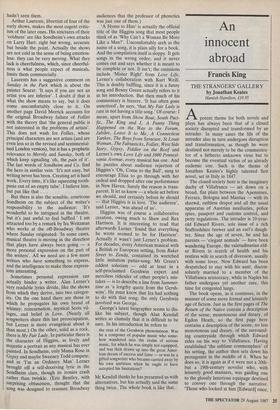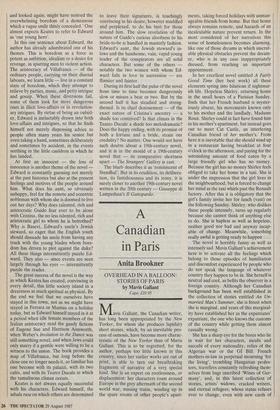An innocent abroad
Francis King
THE STRANGERS' GALLERY by Jonathan Keates
Hamish Hamilton, £10.95
Apotent theme for both novels and plays has always been that of a closed society disrupted and transformed by an intruder. In many cases the life of the intruder also in turn undergoes disruption and transformation, as though he were destined not merely to be the communica- tor of a hitherto unknown virus but to become the eventual victim of an already endemic one. Such is the theme of Jonathan Keates's highly talented first novel, set in Italy in 1847.
The closed society here is the imaginary duchy of Villafranca — set down on a broad, flat plain between the Apennines, Ferrara, Bologna and Mantua — with its shrewd, ruthless despot and all the usual apparatus of Austrian auxiliaries, police spies, passport and customs control, and petty regulations. The intruder is 19-year- old Edward Rivers, sole issue of a rich Staffordshire brewer and an earl's daugh- ter. Since the age of seven, he and his parents — 'elegant nomads' — have been wandering Europe, the valetudinarian eld- er Rivers in search of health and his restless wife in search of diversion, usually with some lover. Now Edward has been despatched to stay with his aunt, discon- solately married to a member of the Villafranca aristocracy, while in Naples his father undergoes yet another cure, this time for congested lungs.
The book opens, as it continues, in the manner of some more formal and leisurely age of fiction. Just as the first pages of The Return of the Native contain a description of the scene, monotonous and dreary, of Egdon Heath, so the first page here contains a description of the scene, no less monotonous and dreary, of the surround- ing countryside through which Edward rides on his way to Villafranca. Having established 'the sublime commonplace' of his setting, the author then sets down his protagonist in the middle of it. When he does so, it is again as if it were not a 20th- but a 19th-century novelist who, with leisurely good manners, was guiding one to the glossily luxurious equipage destined to convey one through the narrative. `Those who looked at him [Edward] once, and looked again, might have noticed the overwhelming boredom of a demeanour which a vague smile thinly concealed.' One almost expects Keates to refer to Edward as 'our young hero'.
In this one sentence about Edward, the author has already adumbrated one of his themes. This is boredom as a force as potent as ambition, idealism or a desire for revenge, in spurring men to violent action. The aristocracy of Villafranca — of the ordinary people, carrying on their diurnal labours, we learn little — live in a constant state of boredom, which they attempt to relieve by parties, music, and petty intrigue and gossip. When these diversions fail, some of them look for more dangerous ones in illicit love-affairs or in revolution- ary intrigues. By virtue of being an outsid- er, Edward is ineluctably drawn into both love-affairs and intrigues, so that he finds himself not merely dispensing advice to people often many years his senior but even taking a hand, sometimes deliberately and sometimes by accident, in the events seething in the little cauldron in which he has landed.
At first an innocent — the loss of innocence is another theme of the novel Edward is constantly guessing not merely at the past histories but also at the present feelings and motives of the people around him. What does his aunt, so obviously unhappy, feel for the remote and eccentric nobleman with whom she is doomed to live out her days? Why does talented, rich and aristocratic Guido fear ever to be alone with Cristina, the no less talented, rich and aristocratic girl to whom he is betrothed? Why is Basevi, Edward's uncle's Jewish steward, so eager that the English youth should dissuade his uncle from having any truck with the young blades whom bore- dom has driven to plot against the duke? All these things intermittently puzzle Ed- ward. They also — since events are seen largely through his eyes — intermittently puzzle the reader.
The great success of the novel is the way in which Keates has created, convincing in every detail, this little society island in a dreariness as much spiritual as physical. By the end we feel that we ourselves have stayed in this town, not as we might have stayed in Ferrara or Mantua on a holiday today, but as Edward himself stayed in it at a period when idle female members of the Italian aristocracy read the gaudy fictions of Eugene Sue and Harrison Ainsworth, when Weber's Invitation to the Dance was still something novel, and when Jews could only marry if a gentile were willing to be a witness to the union. The book provides a map of Villafranca, but long before the close one no longer needs it, so familiar has one become with its palazzi, with its two cafés, and with its Teatro Ducale in which the tumultuous climax occurs.
Keates is not always equally successful with his characters. Edward himself, the tabula rasa on which others are determined to leave their signatures, is touchingly convincing in his desire, however muddled and perplexed, to do his best for those around him. The slow revelation of the nature of Guido's curious aloofness to his bride-to-be is handled in masterly fashion. Edward's aunt, the Jewish steward's in- laws and the handsome, vain, vapid young leader of the conspirators are all solid characters. But some of the others notably the two women with whom Ed- ward falls in love in succession — are flimsier and fainter.
During its first half the pulse of the novel from time to time becomes dangerously slow or misses a beat or two. But by the second half it has steadied and streng- thened. Is its chief denouement — of the exact nature of Cristina's ancestry — a shade too contrived? Is that climax in the Teatro Ducale a shade too melodramatic? Does the happy ending, with its promise of both a fortune and a bride, strain our credulity? No matter. One would not have such doubts about a 19th-century novel, and it is in the mould of a 19th-century novel that — its comparative shortness apart — The Strangers' Gallery is east.
The blurb describes it as 'reminiscent of Stendhal'. But in its erudition, its delibera- tion, its fastidiousness and its irony, it is surely closer to another 19th-century novel written in the 20th century — Giuseppe di Lampedusa's II Gattopardo.











































 Previous page
Previous page